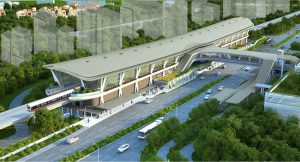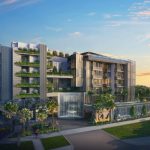Draft Masterplan 2019 envisions that North region connectivity will be enhanced.
By: Hitesh Khan/
2019 will see the opening of several new MRT stations and an Integrated Transport Hub (ITH):
- Canberra MRT on the North-South Line (NSL)
- Woodlands North, Woodlands, and Woodlands South MRT stations on the Thomson-East Coast Line (TEL)
- Yishun ITH

By 2020, North region connectivity will be enhanced by Springleaf MRT along the TEL which will also open.
Table of Contents
Residents can also look forward to the upgraded Woodlands Regional Bus Interchange, which will be connected to the Woodlands MRT interchange station when completed. This will also enhance the North region connectivity.
URA said that with the Draft Masterplan 2019 Singapore’s North Region will be develop more one stop hubs. With the upcoming integrated developments – Bukit Canberra, Canberra Plaza, and Woodlands Health Campus – families in the North will be able to meet their daily needs near their homes.
Draft Masterplan 2019 envisions that people in the North Region will be living well-connected towns
Residents of the North will soon have a variety of new live, work and play options. There will be new amenities and public housing developments planned around existing and upcoming MRT stations, including Canberra MRT.
Bukit Canberra
The upcoming Bukit Canberra will offer Sembawang residents easier access to amenities than ever before. When fully opened in 2021, the integrated development will feature a verdant park-like setting and will include facilities such as a polyclinic, senior care centre, hawker centre, swimming pools, and an indoor sports hall.
New Generation Neighbourhood Centre
When completed in end-2019, Canberra Plaza will feature public housing that is integrated with myriad amenities, including an event plaza, supermarkets, restaurants, food courts and enrichment centres.
Woodlands Health Campus
Comprising both acute and community hospitals, a nursing home, and specialist clinics, the Woodlands Health Campus will offer quality care to residents. It will open progressively from 2022.
The Draft Masterplan 2019 envisions bringing more jobs to the North Region and in providing more growth opportunities
Reimagining Sembawang Shipyard
Once Sembawang Shipyard’s operations cease, the site has the potential to be redeveloped into a mixed-use waterfront lifestyle precinct while taking into consideration its rich maritime history. The shipyard’s unique coastal profile presents opportunities for new waterfront public spaces. Selected buildings can also be re-purposed to introduce suitable uses that will bring new life into the area.
Draft Masterplan 2019 envisions new play spaces in the North Region with green & blue spaces for fun & leisure
Kranji: The Recreation & Community Hub
We will inject more recreational activities and community spaces into Singapore Racecourse so that more people from all walks of life can enjoy the place. Alongside other nearby attractions such as Sungei Buloh Wetland Reserve and the Mandai wildlife parks, Kranji will become a launch pad for fun activities for families, the young and the old.
Green Loop Around Lower Seletar Reservoir
To allow residents to enjoy Lower Seletar Reservoir, URA will progressively create a green walking and cycling loop around the reservoir. Residents will be able to enjoy scenic views and seamlessly connect to the future Round Island Route from Yishun Dam. This will also increase North region connectivity.
Walking & Cycling to Work & Play part of North region connectivity
Today, Sembawang and Yishun residents enjoy an extensive intra-town cycling path network that connects residential areas with key local amenities. Moving forward, more cycling paths and park connectors will make your journeys even smoother.
WoodsVista Gallery
When WoodsVista Gallery is ready, residents will enjoy a seamless pedestrian and cycling connection to Woodlands MRT, Admiralty Park, and all the way to Woodlands Waterfront Park.
The Draft Masterplan 2019 reflects Singapore planners’ people-centric approach to achieving sustainable growth through continuous innovation to enhance the attractiveness of the city, said a Policy Watch report by prominent real estate services agency Cushman & Wakefield (C&W). The key strategies highlighted in the Draft Masterplan 2019 will move Singapore in the right direction towards a sustainable and liveable city of the future, the report added.
Draft Masterplan 2019 focuses on planning sustainable, green, inclusive neighbourhoods, rejuvenating familiar places and creating capacity for our future. Future residential precincts will continue to be sustainable, green, community-centric and car-lite, with easy access to a wide range of public spaces and amenities to meet residents’ needs. Co-locating amenities in one-stop hubs such as the upcoming Bukit Canberra and Punggol Town Hub makes it easier for residents to shop, dine, and engage in family-bonding activities all under one roof.
Agencies are also studying age-friendly designs for neighbourhoods so our seniors can remain independent and healthy in familiar surroundings as they age.
The demand for facilities such as polyclinics, childcare and eldercare centres will evolve as the demographic makeup of housing towns changes. Hence, data analytics and geospatial capabilities are used to examine changing demographic trends, usage patterns, and user profiles to help agencies make decisions on where to locate new facilities, or convert existing ones to cater for new needs. This ensures that URA will continue to meet changing needs with adequate provision of amenities and services that are accessible to residents.
In future, over 90 per cent of households will be within walking distance of a park. More Active Beautiful, Clean (ABC) Waters projects will be completed over the next five years.
Given Singapore’s limited land area, URA has adopted a balanced approach to development and nature conservation. Land has been set aside for greenery, including four Nature Reserves and 20 Nature Areas, so that representative sites of our key native ecosystems are retained. Greenery and biodiversity will continue to be integrated into our urban environment, along our streets and waterways, and on our buildings.






